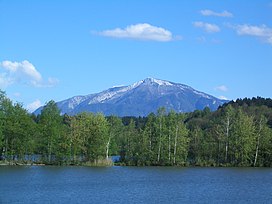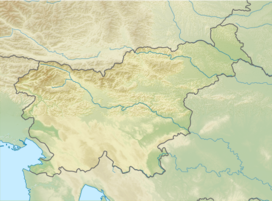
Slovenia is situated at the crossroads of central and southeast Europe, touching the Alps and bordering the Adriatic Sea. The Alps—including the Julian Alps, the Kamnik–Savinja Alps and the Karawank chain, as well as the Pohorje massif—dominate northern Slovenia along its long border to Austria. Slovenia's Adriatic coastline stretches approximately 47 km (29 mi) from Italy to Croatia. Its part south of Sava river belongs to Balkan peninsula – Balkans.

Carinthia, also Slovene Carinthia or Slovenian Carinthia, is a traditional region in northern Slovenia. The term refers to the small southeasternmost area of the former Duchy of Carinthia, which after World War I was allocated to the State of Slovenes, Croats and Serbs according to the 1919 Treaty of Saint-Germain. It has no distinct centre, but a local centre in each of the three central river valleys among the heavily forested mountains.

The Meža (Slovene) or Mieß is a river in the Austrian state of Carinthia and in Slovenia, a right tributary of the Drava. It is 43 kilometers (27 mi) long, of which 42 kilometers (26 mi) are in Slovenia. Its catchment area is 551.7 square kilometers (213.0 sq mi), of which 543 square kilometers (210 sq mi) in Slovenia.

The Karawanks or Karavankas or Karavanks are a mountain range of the Southern Limestone Alps on the border between Slovenia to the south and Austria to the north. With a total length of 120 kilometres (75 mi) in an east–west direction, the Karawanks chain is one of the longest ranges in Europe. It is traversed by important trade routes and has a great tourist significance. Geographically and geologically, it is divided into the higher Western Karawanks and the lower-lying Eastern Karawanks. It is traversed by the Periadriatic Seam, separating the Apulian tectonic plate from the Eurasian Plate.
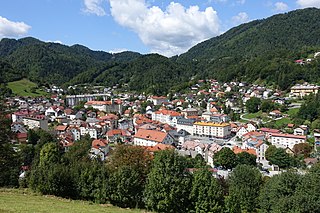
Idrija is a town in western Slovenia. It is the seat of the Municipality of Idrija. Located in the traditional region of the Slovene Littoral and in the Gorizia Statistical Region, it is notable for its mercury mine with stores and infrastructure, as well as miners' living quarters, and a miners' theatre. Together with the Spanish mine at Almadén, it has been a UNESCO World Heritage Site since 2012. In 2011, Idrija was given the Alpine Town of the Year award.
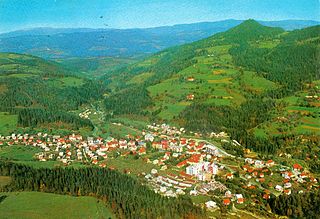
Mežica is a town in northern Slovenia. It is the seat of the Municipality of Mežica. It lies on the Meža River in the traditional Slovenian province of Carinthia) near the Austrian border. The town developed close to a lead and zinc mine under Mount Peca. Mining began in 1665 and ended in 1994. Today the mine is only open for tourist visits.

Tarvisio is a comune (municipality) in the Regional decentralization entity of Udine, in the autonomous Friuli-Venezia Giulia region of Italy.

King Matjaž/Mátyás/Matijaš is a legendary king in Slovenia, Hungary, Croatia and in some other countries, based on pre-Christian traditions of Carantania and in course of centuries gradually linked to a real-life king, Matthias Corvinus of Hungary, who lived in the second half of the 15th century. He has also been linked to the leader of the peasant's army that fought against the Turks in the Battle of Kokovo in July 1478. A number of folk poems and stories about King Matjaž are known, the earliest ones originating in the western Slovene area of Tolmin from the 16th century. He is mainly represented as the king who is just and a defender of his people, and the bringer of the golden age of prosperity. It has been assumed that the legend was the basis for the name of the 1573 peasants' revolt leader Matija Gubec, actually named Ambrož Gubec.
Resia is a comune (municipality) in the Regional decentralization entity of Udine, in the Friuli-Venezia Giulia region of northeast Italy, bordering on the municipalities of Chiusaforte, Lusevera, Resiutta, and Venzone, and also on two of the Slovenian municipalities. Its residents speak an archaic dialect known as Resian, which is – according to most linguists – a transitional dialect between the Carinthian and Littoral dialects of Slovene. Although they maintain their own traditional system of family names, which are of Slavic origin, the people of Resia have either Italian or Italianized surnames, similarly to some areas in Venetian Slovenia.

The Karawanks Tunnel is a motorway tunnel crossing the Alpine Karawanks mountain range between Austria and Slovenia, with a total length of 7.864 km, 8.019 km enclosure between the portals. Its construction began in 1986 and it opened on 1 June 1991. It connects the Austrian Karawanken Autobahn (A11) from Villach with the A2 motorway leading to Kranj and Ljubljana in Slovenia, decongesting the historic Loibl/Ljubelj and Wurzen/Korensko sedlo mountain passes.

The Karawanks Tunnel is the fourth longest railway tunnel in Austria and the longest in Slovenia with a length of 7,976 metres (26,168 ft). It passes under Rožca Saddle between Rosenbach in southern Austria and Jesenice in northern Slovenia.

Carbonate-hosted lead-zinc ore deposits are important and highly valuable concentrations of lead and zinc sulfide ores hosted within carbonate formations and which share a common genetic origin.

Snežnik is a wide karst limestone plateau with an area of about 85 km2 (33 sq mi) in the Dinaric Alps. It can also be viewed as a southern extension of the Julian Alps. The main part of the plateau is in Slovenia, while the southern part extends into Croatia and connects to the mountain region of Gorski Kotar.

Emil Antoni Korytko was a Polish political activist in the period of the Great Emigration, who was exiled to Ljubljana, Carniola and became an important ethnographer, philologist and translator there. His legacy are collections of Slovene folk songs and vivid descriptions of Carniolan folk customs. He significantly contributed to the mutual dialogue between Polish and Slovene authors and readers.

Janče is a dispersed settlement in the hills south of the Sava River east of the capital Ljubljana in central Slovenia. It belongs to the City Municipality of Ljubljana. It is part of the traditional region of Lower Carniola and is now included with the rest of the municipality in the Central Slovenia Statistical Region.
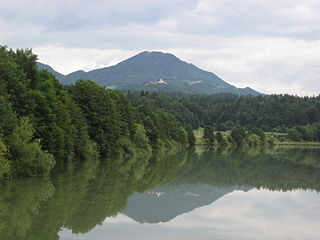
Lisca is a 948-metre (3,110 ft) hill in the eastern part of the Sava Hills in southeastern Slovenia, northwest of Sevnica, north of the Sava, and south of Gračnica Creek. It is the most frequently visited hiking destination in the Sava Hills.

Žirovnica is a settlement in northwestern Slovenia, in the Municipality of Žirovnica. It is located in the historic Upper Carniola region, on the southern slope of the Karawanks mountain range, close to the border with Austria.

The Municipality of Črna na Koroškem is a municipality in northern Slovenia. The seat of the municipality is the town of Črna na Koroškem. It lies in the traditional Slovenian province of Carinthia, close to the border with Austria. Since 2005 it has been part of the larger Carinthia Statistical Region. It borders Austria.

The Geopark Karawanken/Karavanke is located in the Karawanks mountain range in Austria and in Slovenia and comprises an area of 1067 km2. The crossborder geopark has numerous geological and other natural sights and became a member of the UNESCO Global Geoparks Network in 2013.
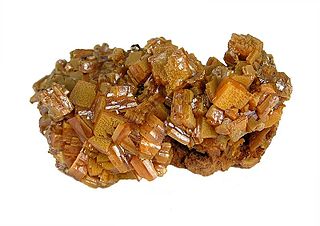
The Mežica Lead and Zinc Mine is one of the oldest mines in Europe, with its first documented mentions dating back to 1665. Located in the Mežica Valley in Slovenia, it played a significant role in the Slovenian mining history.
